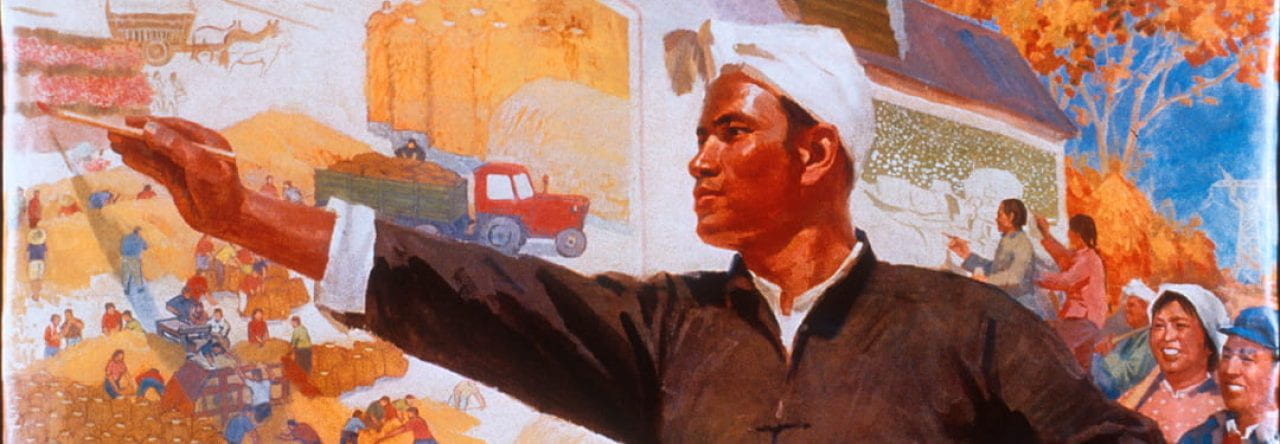
“With the sun in your heart, what is there to fear? Dare to sacrifice your youth with the people.”, Artist unknown, gouache on paper, Shanghai, 1976
For many years in the Communist Party’s reign over China, these posters were a way of connecting the government with its people. This propaganda-producing business usually churned out millions of posters annually, and had become so efficient at creating political posters that it would take less than a day to draft, print, and distribute new material for the masses to consume (Andrews, 2012).The purpose of these posters were to encourage the majority of society- the working class, peasants, farmers, and soldiers- to unite together as equals under one country. In this unity and idyllic society, everyone is treated as equals, which includes men and women. Mao Zedong explicitly states that “women can do the same as men”, and supports them in every way as long as it benefits the party (Evans, 1999). Women are allowed to dress, work, and have the same political power as men. This stance has given women the freedom to appear in artwork in the same company as men and give society examples of what their role is in this “new” China.
This poster below features a line of mostly young women with their arms linked to form a chain. They are forming a human dam against massive tides of water, withstanding the crashing waves with determined expressions. The caption below the poster reads: “With the sun in your heart, what is there to fear? Dare to sacrifice your youth with the people.”, and underneath that caption is another, saying “learn from the eleven educated youths of Shanghai’s Huangshan TeaTree Factory, who feared neither bitterness nor death.” (Evans, 1999). It is a gouache on paper, and is most likely a local propaganda poster. The fact that the image features mainly women goes to show how seriously women’s roles in Communist society were taken. They can bear the same hardships as men with equal resilience and determination. The main woman in the foreground of the work is clutching the “little red book”, a book of Mao Zedong’s sayings that the Red Guard often carried around. She is the only one in this poster whose face is showing fear. Though she appears as a “weak link” who allows the rushing water to pass by the human chain, she is still holding on and has a tight grip on the little red book, thereby solidifying her willingness to stand strong by her government and their beliefs.


Yueqin Chao
One point that I really appreciate your poster is that you described people’s emotion in the poster within so much detailed and could combined with the Female’s social statue at that period of time. You mentioned that one of the female characters appears as a ” weak link” in the poster, which really shocked me because I haven’t mentioned people’s emotion with this kind of meticulous description. Also, you combined Female with Chinese political policy about marriage and Mao’s saying that “women can do same things as men”. These were also important and could help me to refine my poster. One thing I think you have missed in your poster was the description of style of the painting. Is that a realistic style or an exaggerate style? Which parts of the painting fits the style you mentioned? Why or why not ? In conclusion, I really like your work and it helps me a lot on the description of character’s emotion aspect! Hope see your next work!
Paxton Ouellette
As your work also focuses on government-sponsored propaganda, I feel as if there is an important aspect to my own work that I hadn’t yet considered: the representation of women. It is quite interesting that a woman is chosen as the “weak link,” yet is still shown as strong, holding onto Mao’s words even when faced with hardship. Although the bas-relief I focused on in my initial blog post doesn’t show any women, there are others where they are present. Interestingly, I wonder what the intention of them being there (or, perhaps the lack of their presence), looks to represent? Even when women are present, they are never the ones leading others and instead are shown as being a member of the crowd. As my piece looks to bring together the populace of China as political posters would also look to do—allowing individuals to see themselves in a piece of government-sponsored art—I wonder why are women never shown as leaders in my own piece, even if they are portrayed as being equal in the eyes of the Communist Party?
Lily van Baaren
I appreciate Elaine’s dissection of female empowerment shown in this piece. I especially like how Elaine points out that the poster highlights “how seriously women’s roles in Communist society were taken [and that] they can bear the same hardships as men with equal resilience and determination” (Du). This discussion has made me wonder: in what ways does O zhang represent women in her work? Furthermore, are there kinds of Chinese female imagery that perpetuate a sense of false personality– should artists be concentrating on more uplifting or negative female themes? O Zhang certainly captures different types of tones and themes than seen in Elaine’s poster; she often dispels communist glory and national pride, while also testing female sexuality in Chinese culture.